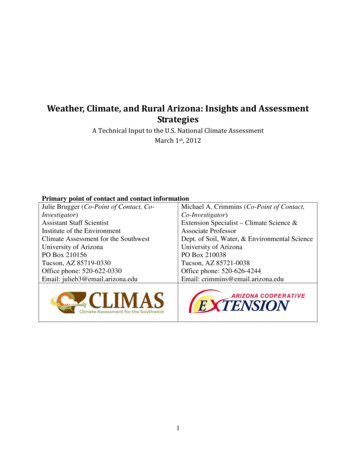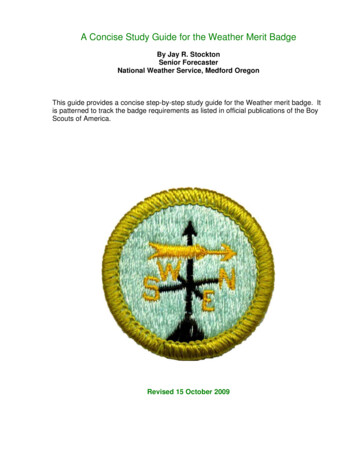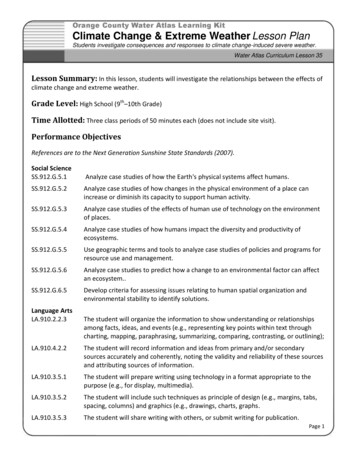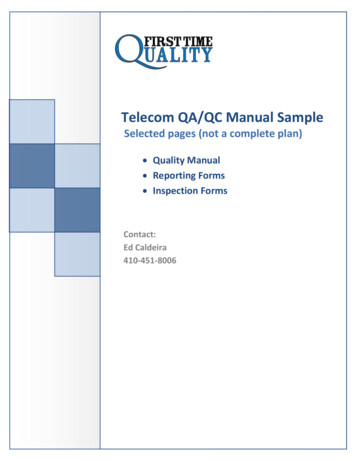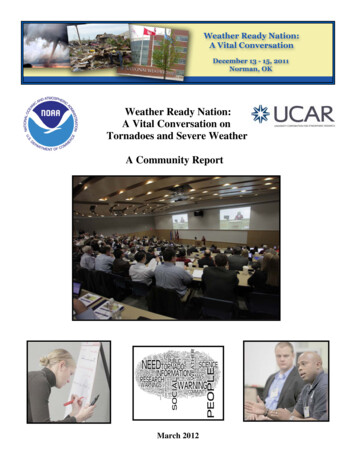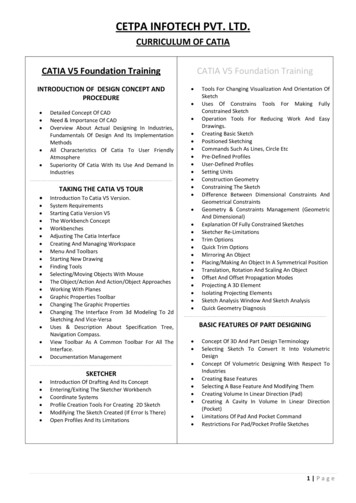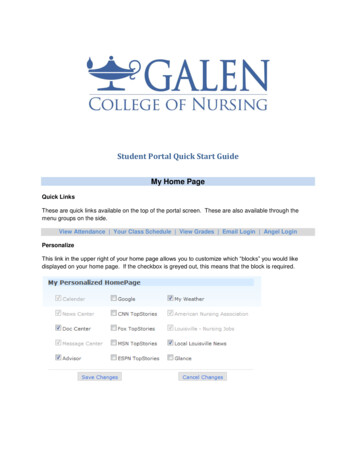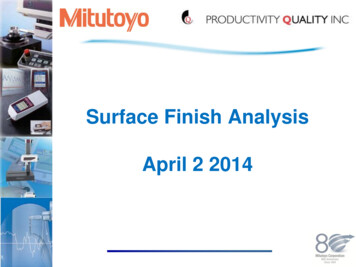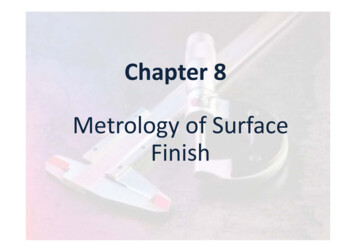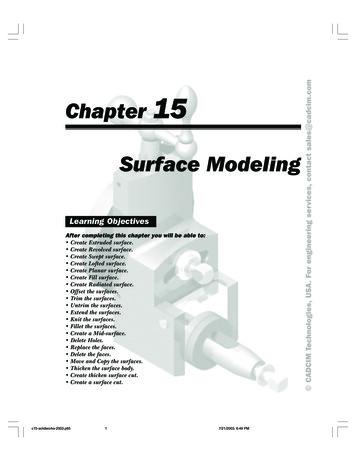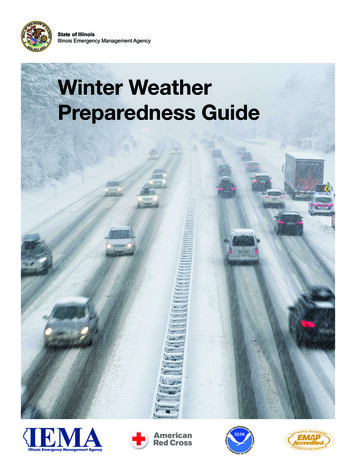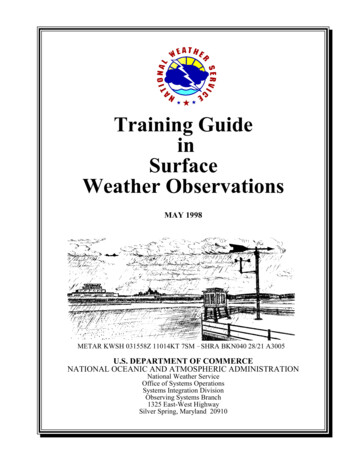
Transcription
Training GuideinSurfaceWeather ObservationsMAY 1998METAR KWSH 031558Z 11014KT 7SM !SHRA BKN040 28/21 A3005U.S. DEPARTMENT OF COMMERCENATIONAL OCEANIC AND ATMOSPHERIC ADMINISTRATIONNational Weather ServiceOffice of Systems OperationsSystems Integration DivisionObserving Systems Branch1325 East-West HighwaySilver Spring, Maryland 20910
NATIONAL WEATHER SERVICE“Serving the Nation Since 1870”
PREFACEMETAR/SPECI is the international standard code for hourly and special surface weather observations.The METAR acronym roughly translates from the French as Aviation Routine Weather Report. Aspecial report, SPECI, is merely a METAR-formatted report which is issued on a non-routine basis asdictated by changing meteorological conditions. The SPECI acronym roughly translates as AviationSelected Special Weather Report.National Weather Service Observing Handbook No. 7, Part I (WSOH #7), and National Weather ServiceObserving Handbook No. 8 (WSOH #8) prescribe aviation weather observing, reporting, and codingprocedures applicable to taking and reporting manual surface observations. They provide a frameworkwithin which meteorological phenomena can be identified and reported in a standardized andunderstandable format. The type of station you are assigned to will determine which National WeatherService Observation Handbook is to be used for your station’s surface weather observing program.WSOH #7 provides procedures and practices for NWS and NWS-contract personnel. WSOH #8prescribes procedures and practices for Supplementary Aviation Weather Reporting Stations (SAWRS).Training Guide in Surface Weather Observations is designed to provide additional information inobserving, recording, and coding of manual surface weather reports. The Training Guide doesn’t includeeverything you need to know. Therefore, it is necessary to use it in conjunction with your station’sWSOH.When you’ve finished reading a chapter in your station’s WSOH, read the discussion in the trainingguide. When you are confident and familiar with the contents of both, proceed to the review questionsat the end of each chapter. Answer each question, but DO NOT guess at the answers. If in doubt, lookup the answer in the appropriate instructions. This will help you become more familiar with theHandbooks.Correct answers to review questions can be found in Appendix A. Use these answers only afteranswering all questions in the chapter. If you made a mistake, locate the appropriate instructions anddetermine where you went wrong.Complete the Observing and Coding Exercises and the Quality Control Exercises in Chapter 9 only afterall other chapters in the training guide are completed. Correct answers to the exercises can be found inAppendix A.Because this Training Guide provides a wide spectrum of information on surface weather observations,some of the information may not be applicable to a station’s observing program. For example, SAWRSare not required to provide 3- and 6-hourly precipitation amounts, 24-hour precipitation amounts, snowdepth on the ground, or water equivalent of snow on the ground data; so a student working at a SAWRSwould not need to study this information. Therefore, students should consider only the information inthis study guide that is applicable to their station’s observing program.i
ii
Table of ContentsPagePREFACE . . . . . . . . . . . . . . . . . . . . . . . . . . . . . . . . . . . . . . . . . . . . . . . . . . . . . . . . . . . . . . . . . . . . . . iCHAPTER 1 - GENERAL . . . . . . . . . . . . . . . . . . . . . . . . . . . . . . . . . . . . . . . . . . . . . . . . . . . . . .Content and Format of the Manual METAR/SPECI . . . . . . . . . . . . . . . . . . . . . . . . . . . . . . . .Type of Report - METAR/SPECI . . . . . . . . . . . . . . . . . . . . . . . . . . . . . . . . . . . . . . . . . . . . . . .Station Identifier - CCCC . . . . . . . . . . . . . . . . . . . . . . . . . . . . . . . . . . . . . . . . . . . . . . . . . . . . .Date/Time Group - YYGGggZ . . . . . . . . . . . . . . . . . . . . . . . . . . . . . . . . . . . . . . . . . . . . . . . . .Report Modifier - COR . . . . . . . . . . . . . . . . . . . . . . . . . . . . . . . . . . . . . . . . . . . . . . . . . . . . . . .Delayed Reports . . . . . . . . . . . . . . . . . . . . . . . . . . . . . . . . . . . . . . . . . . . . . . . . . . . . . . . . . . . .Differences Between Transmitted Coded Report and MF1M-10 Entries . . . . . . . . . . . . . . . .Various Observational Programs . . . . . . . . . . . . . . . . . . . . . . . . . . . . . . . . . . . . . . . . . . . . . . .REVIEW QUESTIONS . . . . . . . . . . . . . . . . . . . . . . . . . . . . . . . . . . . . . . . . . . . . . . . . . . . . . .1-11-21-21-31-31-41-41-41-41-7CHAPTER 2 - WIND . . . . . . . . . . . . . . . . . . . . . . . . . . . . . . . . . . . . . . . . . . . . . . . . . . . . . . . . . .Wind Group - dddff(f)Gfmfm(fm)KT . . . . . . . . . . . . . . . . . . . . . . . . . . . . . . . . . . . . . . . . . . . . .Variable Wind Direction - dndndnVdxdxdx . . . . . . . . . . . . . . . . . . . . . . . . . . . . . . . . . . . . . . . . .Wind Shifts . . . . . . . . . . . . . . . . . . . . . . . . . . . . . . . . . . . . . . . . . . . . . . . . . . . . . . . . . . . . . . .REVIEW QUESTIONS . . . . . . . . . . . . . . . . . . . . . . . . . . . . . . . . . . . . . . . . . . . . . . . . . . . . . .2-12-12-22-22-5CHAPTER 3 - VISIBILITY . . . . . . . . . . . . . . . . . . . . . . . . . . . . . . . . . . . . . . . . . . . . . . . . . . . . . 3-1Prevailing Visibility . . . . . . . . . . . . . . . . . . . . . . . . . . . . . . . . . . . . . . . . . . . . . . . . . . . . . . . . . 3-1Visibility Chart . . . . . . . . . . . . . . . . . . . . . . . . . . . . . . . . . . . . . . . . . . . . . . . . . . . . . . . . . . . . . 3-7Runway Visual Range . . . . . . . . . . . . . . . . . . . . . . . . . . . . . . . . . . . . . . . . . . . . . . . . . . . . . . . . 3-8REVIEW QUESTIONS . . . . . . . . . . . . . . . . . . . . . . . . . . . . . . . . . . . . . . . . . . . . . . . . . . . . . 3-11CHAPTER 4 - PRESENT WEATHER . . . . . . . . . . . . . . . . . . . . . . . . . . . . . . . . . . . . . . . . . . . . 4-1Coding of Present Weather Group(s) . . . . . . . . . . . . . . . . . . . . . . . . . . . . . . . . . . . . . . . . . . . . 4-7REVIEW QUESTIONS . . . . . . . . . . . . . . . . . . . . . . . . . . . . . . . . . . . . . . . . . . . . . . . . . . . . . 4-11CHAPTER 5 - SKY CONDITION . . . . . . . . . . . . . . . . . . . . . . . . . . . . . . . . . . . . . . . . . . . . . . . . 5-1Sky Cover . . . . . . . . . . . . . . . . . . . . . . . . . . . . . . . . . . . . . . . . . . . . . . . . . . . . . . . . . . . . . . . . . 5-2Cloud and Ceiling Heights . . . . . . . . . . . . . . . . . . . . . . . . . . . . . . . . . . . . . . . . . . . . . . . . . . . 5-15Maintenance of Cloud Height Equipment . . . . . . . . . . . . . . . . . . . . . . . . . . . . . . . . . . . . . . . 5-19REVIEW QUESTIONS . . . . . . . . . . . . . . . . . . . . . . . . . . . . . . . . . . . . . . . . . . . . . . . . . . . . . 5-23CHAPTER 6 - TEMPERATURE AND DEW POINT . . . . . . . . . . . . . . . . . . . . . . . . . . . . . . . . 6-1Difference Between Coded Report and MF1M-10 Entries . . . . . . . . . . . . . . . . . . . . . . . . . . . 6-1Reporting Temperature and Dew Point . . . . . . . . . . . . . . . . . . . . . . . . . . . . . . . . . . . . . . . . . . 6-1The Psychrometer . . . . . . . . . . . . . . . . . . . . . . . . . . . . . . . . . . . . . . . . . . . . . . . . . . . . . . . . . . . 6-2Computing the Dew Point . . . . . . . . . . . . . . . . . . . . . . . . . . . . . . . . . . . . . . . . . . . . . . . . . . . . 6-4Obtaining Temperatures from Hygrothermometers . . . . . . . . . . . . . . . . . . . . . . . . . . . . . . . . . 6-7Liquid-In-Glass Minimum and Maximum Thermometers . . . . . . . . . . . . . . . . . . . . . . . . . . . . 6-8Correcting Thermometer Errors . . . . . . . . . . . . . . . . . . . . . . . . . . . . . . . . . . . . . . . . . . . . . . . 6-14Maximum/Minimum Temperature System (MMTS) . . . . . . . . . . . . . . . . . . . . . . . . . . . . . . . 6-15REVIEW QUESTIONS . . . . . . . . . . . . . . . . . . . . . . . . . . . . . . . . . . . . . . . . . . . . . . . . . . . . . 6-17iii
PageCHAPTER 7 - PRESSURE . . . . . . . . . . . . . . . . . . . . . . . . . . . . . . . . . . . . . . . . . . . . . . . . . . . . . .Altimeter Setting - APHPHPHPH . . . . . . . . . . . . . . . . . . . . . . . . . . . . . . . . . . . . . . . . . . . . . . . . .Station Elevation - Hp . . . . . . . . . . . . . . . . . . . . . . . . . . . . . . . . . . . . . . . . . . . . . . . . . . . . . . . .Sea-Level Pressure . . . . . . . . . . . . . . . . . . . . . . . . . . . . . . . . . . . . . . . . . . . . . . . . . . . . . . . . . .Difference Between Coded Report and MF1M-10C Entries . . . . . . . . . . . . . . . . . . . . . . . . . .Altimeter Setting Accuracy . . . . . . . . . . . . . . . . . . . . . . . . . . . . . . . . . . . . . . . . . . . . . . . . . . . .REVIEW QUESTIONS . . . . . . . . . . . . . . . . . . . . . . . . . . . . . . . . . . . . . . . . . . . . . . . . . . . . . .7-17-17-27-27-37-37-5CHAPTER 8 - REMARKS . . . . . . . . . . . . . . . . . . . . . . . . . . . . . . . . . . . . . . . . . . . . . . . . . . . . . . 8-1Some of the More Important Remarks . . . . . . . . . . . . . . . . . . . . . . . . . . . . . . . . . . . . . . . . . . . 8-2Measuring Precipitation . . . . . . . . . . . . . . . . . . . . . . . . . . . . . . . . . . . . . . . . . . . . . . . . . . . . . . 8-5Contractions . . . . . . . . . . . . . . . . . . . . . . . . . . . . . . . . . . . . . . . . . . . . . . . . . . . . . . . . . . . . . . . 8-8Difference Between Coded Report and MF1M-10 Entries . . . . . . . . . . . . . . . . . . . . . . . . . . . 8-9REVIEW QUESTIONS . . . . . . . . . . . . . . . . . . . . . . . . . . . . . . . . . . . . . . . . . . . . . . . . . . . . . 8-11CHAPTER 9 - REVIEW EXERCISESOBSERVING and CODING EXERCISES . . . . . . . . . . . . . . . . . . . . . . . . . . . . . . . . . . . . . . . 9-1QUALITY CONTROL EXERCISE . . . . . . . . . . . . . . . . . . . . . . . . . . . . . . . . . . . . . . . . . . . . 9-13APPENDIX A - ANSWERS TO CHAPTER and REVIEW EXERCISESANSWERS TO CHAPTER QUESTIONS . . . . . . . . . . . . . . . . . . . . . . . . . . . . . . . . . . . . . . A-1ANSWERS TO OBSERVING and CODING EXERCISES - CHAPTER 9 . . . . . . . . . . . . A-21ANSWERS TO QUALITY CONTROL EXERCISE - CHAPTER 9 . . . . . . . . . . . . . . . . . A-23APPENDIX B - DEW POINT TABLE . . . . . . . . . . . . . . . . . . . . . . . . . . . . . . . . . . . . . . . . . . . . B-1APPENDIX C - TRANSMISSION FORM FOR MANUAL OBSERVATIONS,WS Form B-11 . . . . . . . . . . . . . . . . . . . . . . . . . . . . . . . . . . . . . . . . . . . . . . . . . . . . . . . . . . . . . C-1APPENDIX D - ORDER OF OBSERVING ELEMENTS . . . . . . . . . . . . . . . . . . . . . . . . . . . . D-1iv
CHAPTER 1GENERALThis chapter introduces you to the Aviation Weather Observation and some of the procedures used inthe observing program.1.1 General Information1.1.1 The Aviation Weather ObservationAn Aviation Weather Observation is used to report the various meteorological elements that togetherdescribe the atmosphere as observed and evaluated from the observer’s position. The meteorologicalelements normally observed are: Wind, Visibility, Present Weather, Sky Condition, Temperature, DewPoint, Altimeter Setting, and Remarks.Learning what to observe and how to report your observation is described in National Weather ServiceObserving Handbooks (WSOH #7 and WSOH #8). The format of these Handbooks is such thatinformation concerning an element is contained in its named chapter. A separate chapter covers codinginformation for all elements and information for entries on Meteorological Form 1M-10 (MF1M-10) forall elements provided in separate chapters.1.1.2 Meteorological Form 1M-10 (A, B, and C)1MF1M-10 (A, B, and C) are the standard forms used to log observations. The form your station usesis the official record of observations taken and disseminated by your station. If you make a mistake onthe form, correct the error with the same black ink used to record the observation. Whether the error wasdiscovered before or after the dissemination of the observation, correct the erroneous data by clearlydrawing a single line through the error. Do not erase or obliterate the entry by writing over it or bycovering it up.The accuracy of the actual time of the observation is of the utmost importance in aviation safetyinvestigations. Therefore, the station clock needs to be checked daily at part-time stations, on each shiftat full-time stations, or if there is an aircraft mishap. Time checks are logged in column 65 of MF1M-10.By the second working day of the following month, send the originals of all MF1M-10’s used duringthe month to the National Climatic Data Center. SAWRS send their original MF1M-10C forms usedduring the month to the station designated by the NWS regional headquarters. This station will checkthe forms and advise the SAWRS of any corrections required on the forms by means of WS Form B-14,“Notice of Corrections To Weather Records.” Make corrections to the associated MF1M-10 forms thatare on hand. SAWRS with more than one observer shall post the B-14 so that all observers can reviewit. These notices are an excellent aid for the station’s on-going training and quality control programs.Once the MF1M-10 is reviewed, the correction notices along with the associated copies of the weatherrecords shall be retained in accordance with the local guidelines provided by the supervising office. Iflocal guidelines were not provided, you may discard the records when they are 90 days old.1The MF1M-10A, B, and C have the same column numbers and designations.1-1
1.2 Content and Format of the Manual METAR/SPECIThe following is an overview of the various elements in a METAR/SPECI report. Each element isdescribed in the following paragraphs and chapters. Each element or group is separated by a space ina transmitted report.a. Body of report.(1)(2)(3)(4)(5)(6)(7)Type of Report - METAR or SPECIStation Identifier - CCCCDate and Time of Report - YYGGggZReport Modifier - CORWind - dddff(f)KT dndndnVdxdxdxVisibility - VVVVVSMRunway Visual Range - RDRDR/VRVRVRVRFT orRDRDR/VNVNVNVNVVXVXVXVXFT(8) Present Weather - w0w0(9) Sky Condition - NsNsNshshshs or VVhshshs or SKC(10) Temperature and Dew Point - T0T0/T0dT0d(11) Altimeter - APHPHPHPHb.Remarks Section of Report - RMK(1) Manual and Plain Language(2) Additive Data1.3 Type of Report - METAR/SPECIThe type of report is the first element of the coded report.The type of report shall be METAR for a routine report and SPECI for a special report. Transmittedreports shall always begin with either METAR or SPECI, entered as M or S in column 1 of MF1M-10.1.3.1 METARMETAR is a routine scheduled observation and is the primary observation code used in the United Statesto satisfy requirements for reporting surface meteorological data. METAR contains a report of wind,visibility, present weather, sky condition, temperature, dew point, and altimeter setting collectivelyreferred to as “the body of the report.” In addition, information that elaborates on data in the body ofthe report may be appended to the METAR. This significant information can be found in the sectionreferred to as “Remarks.”1.3.2 SPECISPECI is an unscheduled observation. SPECI observations are taken when specific weather conditionshave been met or observed (noted). SPECI reports shall contain all the data elements found in aMETAR report (except single-element special) plus additional plain language information that elaborateson data in the body of the report. All SPECIs shall be made as soon as possible after the relevant specialcriteria are met or observed. Whenever SPECI criteria are met or observed at the time of a METAR, thetype of report shall be METAR. Single-element special observations are authorized to be taken fortornadic activity and volcanic eruptions.1-2
There are two categories of criteria for taking SPECIs. The first is applicable to all stations across theUnited States. The second category of criteria for taking SPECIs is determined by you the observer. Itallows you to take a SPECI observation to report any phenomenon that in your opinion is operationallysignificant at your station. In making these SPECI reports, there are no limits. Even if no provision ismade for reporting a particular occurrence, take a SPECI and report the phenomenon even if it isnecessary to use plain language in Remarks.1.4 Station Identifier - CCCCThe second element of the transmitted coded aviation weather report is the Station Identifier:This is entered on MF1M-10 in the heading block labeled SID.The METAR/SPECI uses the International Civil Aviation Organization (ICAO) four-letter stationidentifier. All airports in the 48 contiguous states begin with the letter “K” followed by the three-letteridentifier for the airport. Alaskan stations all begin with “PA” for Pacific-Alaskan, Hawaiian stationsbegin with “PH” for Pacific-Hawaiian. The “PA” or “PH” is followed by the international two-letteridentifier for that station.Stations in the Eastern Caribbean begin with the letter “T”; Western Caribbean stations begin with theletter “M”; Guam stations begin with the letters “PG.”Examples:New Iberia, LA - KARASugar Land, TX - KSGRNome, AK - PAOMKeahole Point, HI - PHKOAlexandria, LA - KAEXAnchorage, AK - PANCHonolulu, HI - PHNL1.5 Date/Time Group - YYGGggZThe third element of the coded aviation weather observation is the Date/Time group.YY - two-digit date GG - two-digit hourgg - two-digit minutesZ - letter indicator for UTCIn the METAR/SPECI, the day and time of observation is a six-character field plus the letter “Z.” Thefirst two digits “YY” are the day of the month and the next four digits “GGgg” are the time. The timesentered are in reference to the 24-hour clock. The letter “Z” is added to the end of the group to indicatethe date and time are in Coordinated Universal Time.The date and time are included in all reports. The actual time of a METAR report is the time the lastelement of the observation was observed. The actual time of a SPECI report is when the criterion fora SPECI is met or noted. If the report is a correction to a previously disseminated report, the time of thecorrected report shall be the same time used in the report being corrected.Examples:An observation taken on the 23rd of the month at 1955 UTCMETAR KARA 231955ZAn observation taken on the 1st of the month at 0550 UTCMETAR KAEX 010550ZAn observation taken on the 10th of the month at 0005 UTCSPECI PAOM 100005Z1-3
An observation taken on the 20th of the month at 4:35 PM UTCSPECI PHKO 201635Z1.6 Report Modifier - CORThe Report Modifier falls between the “Date/Time” group and the “Wind” group when used. The onlymodifier for the report will be COR. COR indicates the report is a correction to a previouslytransmitted report. Corrections transmitted shall consist of the entire corrected report. The original dateand time of the report shall be used as the date and time in the corrected report.Example of a Transmitted Corrected Report:METAR KOKC 011955Z COR 22015G25KT 3/4SM TSRA BR OVC010CB 18/16 A2992 RMKFRQ LTGIC TS OHD MOV ECorrections to a still valid observation should be given to everyone who received the erroneous data.1.7 Delayed ReportsIf an observation is taken but cannot be transmitted before the next regularly scheduled report, only thelatest report shall be transmitted. The remark FIBI (Filed But Impractical to Transmit) shall beappended in parentheses to the report that was not transmitted to indicate the report was not transmitted.The remark FIBI shall not be included in local dissemination of the report.Reports of Volcanic Eruption shall be disseminated by any means possible, regardless of the delay.1.8 Differences Between Transmitted Coded Report and MF1M-10 EntriesWhen reviewing your station’s WSOH, you should have noticed there are some differences betweenthe transmitted coded report and entries made in the columns on MF1M-10 (see Exhibit 1-1). Thecoded report contains certain “letter indicators” to show the unit of measure used, time standard used,or to separate “the body of the report” from the “remarks” section of the report, while such entries arenot made on MF1M-10. This training guide highlights where these differences exist in each element.Failure to place the correct “letter indicator” in its proper location or to place a required space in thetransmitted coded report may result in the report not being decoded properly. For example, the reportwill not be decoded if the “Z” is not placed after the date/time group. The observation will not makeit into hourly roundups, etc.1.9 Various Observational ProgramsBecause of the great variety of observational programs, it is impractical to explain in this training guidehow the various observations apply to each station. Therefore, you should discuss this part of theprogram with either the Surface Observation Specialist from the NWS regional headquarters or witha visiting representative from the supervising station.1-4
TYPEM/STIMEG LSTG GUST(Knots)VARIABILITY(True)(3)(4)(5)(6)M 065 34 10 20SUR- TOWERFACE(7a)1/(7b)PRESENTWEATHERSKY CONDITIONTEMP. DEWPOINT ALTIMETERSETTING(Ins.)REMARKS AND SUPPLEMENTAL CODED DATA(9)(10)(11)(12)(13)(14)RUNWAY VISUALRANGE(Feet)(8)-SN BLSNBKN003OVC020-02 -05 2986VIS NW 1/4METAR KEFD 210654Z 34010G20KT 1/2SM -SN BLSN BKN003 OVC020 M02/M05 A2986 RMK VIS NW 1/4The time in column 2 must also be checked. The block to be checked depends on the observing program. Most SAWRS will check UTC,but a few SAWRS are required to check the LST block. SAWRS should check with their supervising NWS office.Exhibit 1-1. MF1M-10 - Difference Between Form Entries and Transmitted Report.1-5
1-6
REVIEW QUESTIONS1.What are the designators used on coded aviation weather observations for the following types ofreports?a.Routine reportb.Unscheduled report2.Weather conditions being equal, why should you allow more time for taking observations at nightthan during the day?3.If you decide at the time of an observation that the normal procedures given in your station’sHandbook are inappropriate for circumstances at hand, what should you do?4.How often should time checks be made on the official station clock used as the station standard?5.How long are you required to retain carbon copies of MF1M-10?6.When the actual cloud height or visibility falls midway between two reportable values, which valueis reported?7.The time of observation, which is entered in column 2 for most SAWRS, is in:a.b.c.d.UTCLSTLDTGMT8.Under what conditions may you omit taking a SPECI when notified of an aircraft mishap?9.If you discover an error in column 9 after you have given the observation to the tower, youshould correct the error by:a.b.c.d.erasing the erroneous entry and entering the correct data in rederasing the erroneous entry and entering the correct data in blackdrawing a line through the erroneous entry and entering the correct data in reddrawing a line through the erroneous entry and entering the correct data in black10. All time entries in column 2 of MF1M-10 are made with reference to theclock.hour11. The primary observation code to be used in the U.S. to satisfy requirements for reporting surfacemeteorological data is:a.b.c.d.METARSASAWRSsynoptic1-7
12. A METAR observation containsa.b.c.d.1, the body of the report1, the remarks2, the body of the report and the remarks3, the time, the data, and the remarks13. A SPECI observation containsa.b.c.d.section(s),section(s),.1, the body of the report1, the remarks3, the time, the data, and the remarks2, the body of the report and the remarks14. Which of the following meet SPECI criteria? (more than one answer):the wind speed is 15 kt while the wind direction changes by 60 degrees in 10 minutessurface visibility drops from 2 1/2 miles to 2 milesa tornado is observedhail intensity changesthunderstorm beginsthe ceiling changes from 3,000 ft to 2,500 ft AGLa new cloud layer is observed below 1,000 ft AGLan aircraft mishap occurssqualls occur15. Regardless of the delay, observations containing which of the following elements must bedisseminated?a.b.c.d.volcanic eruptionstornadoesthunderstormsblizzards16. If SPECI criteria are met or observed at the time a METAR observation is due, it is coded as a:a.b.c.d.METARSPECIRSPECIRS17. The station identifier is the element in a METAR/SPECI coded report.a.b.c.d.firstsecondthirdsixth1-8
18. The ICAO identifier usesa.b.c.d.letters.threefivetwofour19. Which report includes the Date and Time group?a.b.c.d.METARSPECISAboth METAR and SPECI20. In a METAR report, the time of the Date/Time group is:a.b.c.d.the time the observation is disseminatedactual time of the reporttime the last element is observedboth b and c21. In a SPECI report, the time of the Date/Time group is:a.b.c.d.the time the observation is disseminatedthe time of the last METAR reportwhen the criterion for a SPECI is met or noted5 minutes before the event was noticed22. Which time will be used for the Date/Time group if the report is a corrected one?a.b.c.d.same time used in the report being correctedtime when the error was noticedtime when the last element was entered on the corrected reporttime of the next METAR or SPECI report23. Code the following Date/Time groups. All times are in UTC.a.b.c.d.e.1st of month at 10019th of month at 175515th of month at 204530th of month at 01137th of month at 162524. In a manual observation, what is the only report modifier used?a.b.c.d.AUTORMKTMPCOR1-9
25. At no time shall an observation be started more thanobservation time.minutes prior to the scheduled26. Corrected reports are not transmitted if they are:a.b.c.d.more than 15 minutes oldsuperseded by a later reportrecorded locallyonly minor corrections27. What remark is appended to the report of a METAR or SPECI observation that is nottransmitted?28. People authorized to take weather observations:a.b.c.d.need no training or certificationmust have training but not certificationmust be certified by the National Weather Serviceare not paid29. Place the following groups in the order in which they occur in METAR/SPECI:date and time of reportsky conditionvisibilitytype of reportpresent weatherreport modifieraltimeterwindtemperature and dew pointstation identifiermanual and plain language remarks30. If an element does not occur or cannot be observed, it is:a.b.c.d.marked missingestimatedomitted from the reportadded from complementary data31. The time of observation, which is entered in Column 2 for the NWS, is in:a.b.c.d.UTCLSTLDTGMT1-10
CHAPTER 2WIND2.1 Wind Group - dddff(f)Gfmfm(fm)KTThe wind group is the first weather element reported in a METAR/SPECI and immediately follows theDate/Time group in the transmitted coded report.Observing and reporting wind speed and direction are relatively easy.2.1.1 Wind Direction - dddThe direction is reported using three characters. When using direct reading dials, you determine thewind direction by averaging the direction over a 2-minute period. The true wind direction is reportedin tens of degrees using three digits. The third character will always be a zero. See Table 2-1, WindDirection in Tens of Degrees.2.1.2 Wind Speed - ff(f)Wind speed is reported using two digits or three when necessary. If the direction was determined to bevariable (VRB) and the wind speed is 6 knots or less, the speed is appended to the VRB, e.g., VRB05.However, wind directions should be reported whenever they can be determined even when the windspeed is 6 knots or less, e.g., 14004. A calm wind (less than 1 knot) is coded with five zeros, e.g.,00000. The transmitted coded group ends with the letters “KT” to indicate the unit of measurement isin knots; however, it is not recorded on MF1M-10.Examples of Transmitted/Coded Data: 31015KT14004KTVRB04KT040112KT00000KT2.1.3 Wind Gusts - Gfmfm(fm)Reporting gusts is a bit more difficult. The wind gust is coded in two or three digits immediatelyfollowing the wind speed. The wind data for the most recent 10 minutes are evaluated. Gusts areindicated by rapid fluctuations in wind speed with a variation of 10 knots or more between peaks andlulls. The speed of the gust shall be the maximum instantaneous wind speed. The letter “G” is placedright before the wind gust speed in the transmitted coded report; however, it is not recorded in column5 of MF1M-10.Examples of Transmitted/Coded Data: 31015G25KT090115G125KTSqualls are reported in Present Weather and are also part of what makes up the wind character. A Squallis a sudden increase in average wind speed of at least 16 knots and sustained at 22 knots or more andlasting for at least 1 minute. The difference between Gust and Squall is duration and intensity of theincrease.2-1
2.1.4 Estimated WindsThough winds can be estimated, there is no way to indicate that wind direction or speed has beenestimated in the coded transmitted report.2.2 Variable Wind Direction - dndndnVdxdxdxIf the wind direction varies by 60 or more and wind speed is 6 knots, a variable wind group is alsoreported. The extreme values are coded using three digits for each direction (remember: tens of degrees,last digit is always a zero). A “V” separates the two extreme values.Example:31015KT 270V340, 36012KT 330V030, 35012KT 320V020The directional variation shall be coded in a clockwise direction (remember: it can vary by more than60 ).Example: If wind is variable from 180 to 250 at 10 knots, it would be coded as:21010KT 180V2502.3 Wind ShiftsWind shifts and the time of occurrences are reported in the remarks section (RMK) of the report. Awind shift is indicated by a change in wind direction of 45 degrees or more in les
The METAR acronym roughly translates from the French as Aviation Routine Weather Report. A special report, SPECI, is merely a METAR-formatted report which is issued on a non-routine basis as dictated by changing meteorological conditions. The SPECI acronym roughly translates as Aviation Selected Special Weather Report.
